 |
The group of scientists for the study of anthropogenic pressure on the functioning of the parasitic system: pathogen vector |
 |
The group of scientists for the study of anthropogenic pressure on the functioning of the parasitic system: pathogen vector |
The group consists of the two Leading Research Associate, two PhD students and three temporary hired, seasonal technicians and (periodically) collaborators from the other Russian institutions.
Chief of the group Prof., Dr. Med. Sci. Andrey N. Alekseev.
research is identifying the principals of the vector pathogen (pathogens) system existence within changing conditions of external environment under anthropogenic influence.
The principle area of the groups research since 1992 have been: parasite interaction (human pathogens in this case), heterogeneity of population host-carriers and vectors of infections (Ixodes tick), changing ecological conditions of parasite vector system existence, and biological markers of infectious diseases.
Research was conducted in the natural foci of contagious diseases of Saint-Petersburg area, of the Curonian Spit reserve (Kaliningradskaya oblast), and other regions of our country (Velikiy Novgorod, Vologda and others), also overseas (Denmark). The similarity of most of the territories is their location in the northern-western region. The main difference (excluding climatic one) is the existence of allopatric populations of Ixodes ticks: Ixodes persulcatus and Ixodes ricinus which are isolated from each other.
Monitoring location: taiga tick collection Ixodes persulcatus -
forest massif Morskaya Lisiy Nos, Saint-Petersburg vicinity, recreational area intensively visited by the citizens, forest tick collection Ixodes ricinus (1996-2002) in Curonian Spit reserve, Kaliningradskaya oblast. Both locations of the study are places with stable encephalitis, borreliosis, and erlihiosis foci.
Tick collection on a flag in the natural environment.

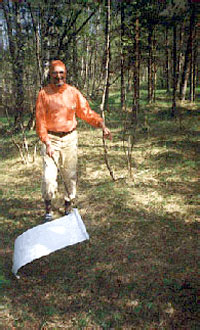
During four years, collection continued every day. The abiotic factor data such as temperature and humidity on the three levels (air (1.5 m. above soil), soil surface, and underlay 0.01-0.015 m. deep) was considered simultaneously.

During two years, light on the soil surface and 1.5 m. above the surface was studied.
The results of the research have shown that the leading factor coincident with the appearance of taiga ticks from under the underlay is the drop of temperatures between the soil surface and the litter.
Tick selection in the laboratory according their developmental stages, their sex, and the presence of exoskeleton anomalies. The ticks were held in the test tubes with differentiated humidity.
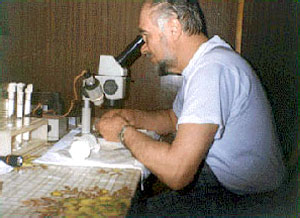
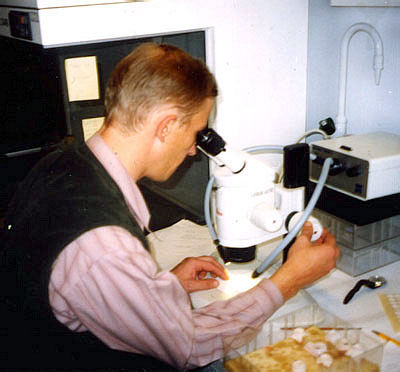
In 24-48 hours after their collection the ticks were located on a ticksdrome (a device designed by Prof. Andrey N. Alekseev) for the recording data about their activity.
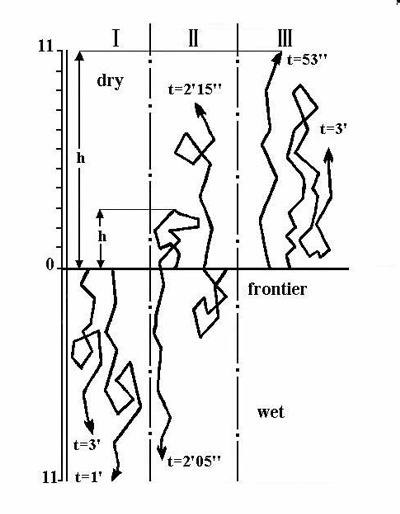
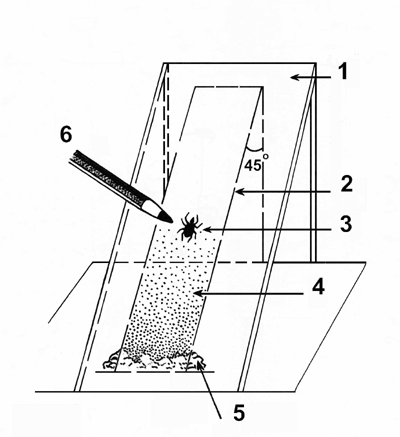
Then the ticks were anatomized and processed for receiving data about their infection with various pathogens, and their belonging to different genotypes.


A locomotor activity index (LAI) was calculated for each specimen using the modified equation, published by Alekseev (1996):
LAI = s/s' + h/h' + wa + wb m/m f/f
where:
s speed (cm/min);
s 1 cm/min;
h height of tick movement (cm);
h 1 cm;
wa portion of the upward path relative to the total path;
wb portion of the path above the humidity gradient;
m meander, the number of turns to the length of the path;
m 1 number of turn to the length of the path;
f number of falls from or on the ticksdrome surface;
f 1 fall from or on the ticksdrome surface (Alekseev, Jensen, Dubinina et al., 2000).
Every individual was studied by the following methods:
Types of exoskeleton anomalies of taiga tick Ixodes persulcatus females that appear due to environmental pollution, mainly with heavy metal ions, are various. The places of anomalies are indicated with arrows. Spine scutum changes are the most frequent (97.8 % pathologies).
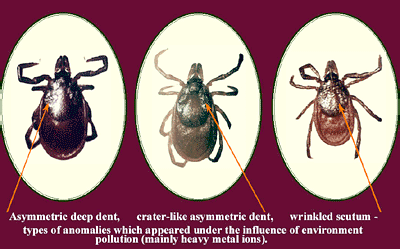
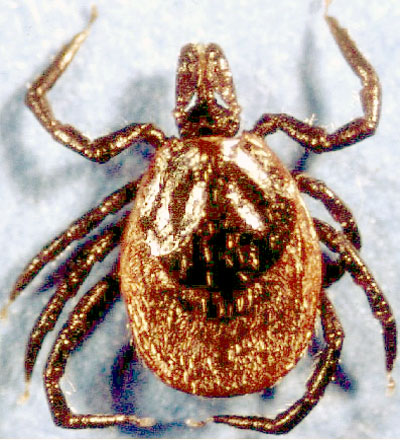

Anomalies in Ixodes, which appeared in the polluted areas in the megapolis vicinity allow to subdivide the vector population into two parts with different vector capacity. Ticks with exoskeleton anomalies that are infected with borreliae are more active. They attack people more often. Percentages of infected ticks and of mixed infections are higher among them.

Tick anomaly expansion allows to make conclusions about area pollution not just at the moment of research but in dynamics.
Decade study in Saint-Petersburg vicinity showed decrease of anthropogenic pressure in 1992-1995 and its increase starting since 1998 until present.

Energetic resources of species define their ability of survival, receiving, storing, and pathogens of transmission. These resources are defined by their genotypic differences that are defined by the cycle Krebs ferments. The identification of ticks in the researched focus is done by one of the ferments malatdehydrogenase (MDH).
Scanned electroforetypes are shown.

Three of six genotypes found in ticks Ixodes are shown.

Genotypes of gene group 1 are predominating in the population.
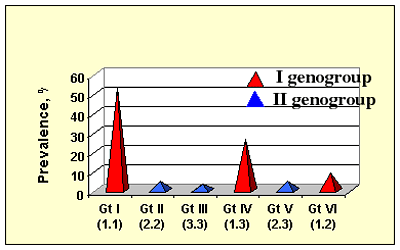
Different regions are distinct by the variety of genotypes of the same vector type. That possibly defines the differences of their ability to transmit different agents.
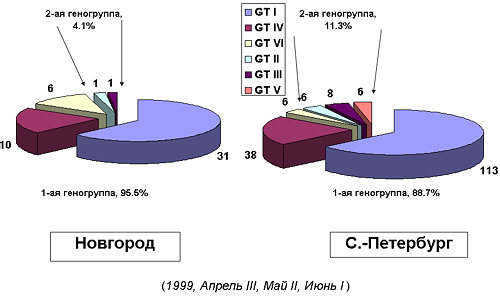
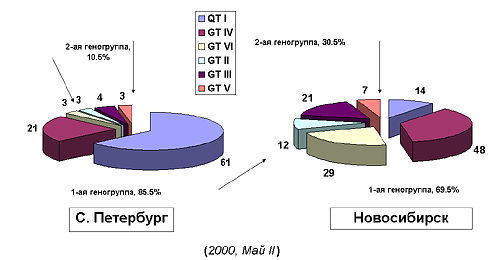
Viruses: of Western (TBE) and Eastern (RSSE) tick encephalitis.
Bacterial infections: Borreliosis agents: Borrelia afzelii, Borrelia garinii, Borrelia burgdorferi sensu stricto (first time in Russia in ticks taken from natural environment). Ehrlichiosis agents: Ehrlichia muris (agent of monocitar ehrlichiosis HME) and agent of granulocytic ehrlichiosis (HGE) in tick collection from the plants (first time in Russia) and from migrating birds (first time in the world). Babesiosis agent: Babesia sp.
Agent of filaruosis of ruminants: nematode Dipetalonema (first time in taiga ticks Ixodes persulcatus).
Borrelia distribution among genotypically different ticks is similar to the one of the not infected part of the population. (1). Parasites with intracellular developmental phase (2) are found in the majority of cases among species of the first gene group.

Ticks of the first gene group have the first, the molecular heaviest, allel of enzyme malatdehydrogenasis. When infected with borreliae they have higher locomotor activity. It increases their epidemiological risk, as it is shown by the study.
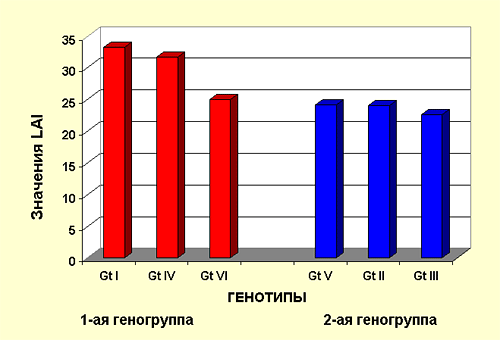
Their belonging to the first gene group causes the highest risk of infected tick attacks of people during daytime in the most dangerous season (April May).
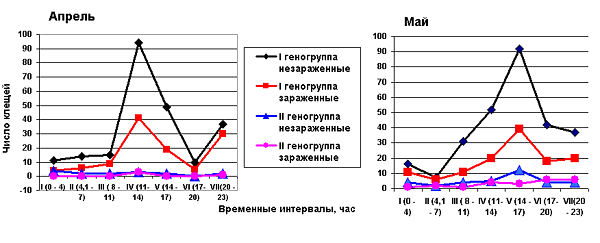
The majority of ticks with anomalies belong to the first gene group. The summation of characteristics of the first gene group abnormal ticks with increased locomotion correlates with tick borreliosis morbidity as during the years of study as during active season of vectors.
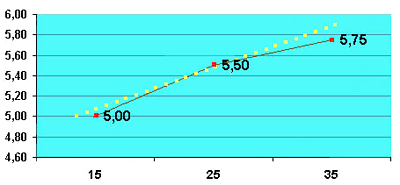
There was discovered correlation between borreliosis morbidity and the extensiveness of abnormal female Ixodes persulcatus infection with borreliae in Saint-Petersburg vicinity (1992-2000).

There was also concluded that the morbidity during the season in the borreliosis focus depends on the number of females Ixodes persulcatus infected with pathogenic borreliae (that are identified by the PCR method) and on their locomotor activity.
Created by the authors model allowed to reveal correlations between variable characteristics of population Ixodes persulcatus representatives (anomalies, belonging to a certain genotype, infectedness etc.) and their locomotion which influents, as it was shown above, morbidity in season.
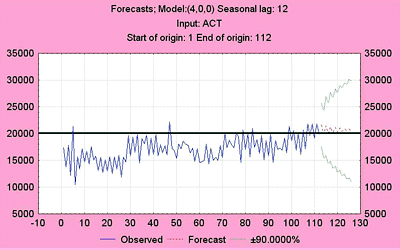

The model allows to predict tick locomotion changes in the next season and its possible risk of epidemics.

The research was made possible by virtue of the grants of the Russian Foundation for Basic Research, International Soros Fund, and Russian-Danish agreement. These grants allowed the reporting of research results at the multiple local and international forums (about 60 reports) and the publication of over 100 articles and 2 monographs.